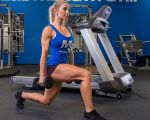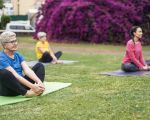Understanding the Importance of Strength Training for Older Adults
As we age, maintaining muscle strength becomes increasingly important for overall health and well-being. Not only does strength training help prevent the loss of muscle mass, but it also plays a critical role in improving balance, boosting metabolism, and preventing chronic conditions such as osteoporosis and arthritis. When it comes to older adults, strength programs are an excellent way to ensure that they can maintain independence and continue to perform daily activities with ease.
1. Why Strength Training is Crucial for Seniors
Many older adults face challenges such as reduced muscle mass, joint stiffness, and decreased mobility. Regular strength training programs can help reverse or at least mitigate these effects. By focusing on building muscle, older adults can improve bone density, reduce the risk of falls, and enhance posture. This leads to a higher quality of life, increased independence, and fewer injuries.
Additionally, strength training can help improve cardiovascular health, regulate blood sugar levels, and boost mental health. Studies have shown that seniors who engage in strength training programs are less likely to suffer from depression and anxiety, making it an essential component of any fitness regimen for older adults.
2. Recommended Strength Training Exercises for Seniors
When designing strength training programs for older adults, it's essential to focus on exercises that are safe, effective, and low-impact. Here are some exercises that are commonly recommended for seniors:
- Chair Squats: This exercise helps strengthen the legs and improve mobility. By sitting down in a chair and standing back up, seniors can target their quads, hamstrings, and glutes.
- Wall Push-Ups: Wall push-ups are a great way to build upper body strength without putting too much strain on the shoulders and wrists. Standing at an angle to the wall and pushing against it helps build arm, chest, and back muscles.
- Resistance Band Exercises: Resistance bands provide gentle resistance and can be used for various exercises to strengthen arms, legs, and core. These bands are also portable and easy to use.
- Step-Ups: Using a low step or a sturdy platform, seniors can perform step-ups to enhance leg strength and improve balance.
- Seated Leg Extensions: This simple exercise can help increase knee strength and improve mobility, especially for those with joint pain.
These exercises can be easily modified to suit different fitness levels, and it's recommended to start slowly with lighter weights or resistance to prevent injury. Over time, seniors can increase the intensity and duration of their workouts as they build strength and endurance.
3. Creating a Personalized Strength Program
While general exercises are great for beginners, it's important to create a personalized strength training program tailored to the specific needs and goals of each individual. Older adults should consult with a fitness professional or healthcare provider before starting any strength program to ensure it's safe and suitable for their health condition.
A well-rounded strength program should include:
- Upper Body Strength: Focus on exercises that target the arms, shoulders, and chest.
- Lower Body Strength: Incorporate squats, lunges, and leg presses to maintain mobility and prevent falls.
- Core Strength: A strong core helps maintain balance and posture, reducing the risk of falls.
- Flexibility and Mobility: Include stretching and mobility exercises to keep the joints flexible and prevent stiffness.
For seniors who are new to strength training, starting with two to three sessions per week is ideal. As they become more comfortable, they can gradually increase the frequency and intensity of their workouts.
4. The Role of Nutrition in Strength Training
It's not just about exercising; nutrition also plays a vital role in building and maintaining muscle mass. Older adults should focus on a diet rich in protein, as it helps in muscle repair and growth. Foods such as lean meats, fish, eggs, beans, and legumes are great sources of protein. Additionally, vitamins and minerals like calcium, vitamin D, and magnesium support bone health and overall well-being.
Hydration is another crucial factor. Older adults are more prone to dehydration, which can negatively impact muscle function and performance. Ensuring adequate fluid intake is essential for seniors engaging in any fitness program, including strength training.
5. Incorporating Cardio with Strength Training
While strength training is crucial for building muscle, combining it with cardiovascular exercise is also important. Cardio exercises such as walking, swimming, or cycling can help improve heart health, increase stamina, and aid in weight management. A balanced fitness routine that includes both strength and cardio can help seniors achieve optimal health and fitness.
6. Success Stories and Real-Life Examples
There are numerous inspiring stories of older adults who have transformed their lives through strength training. For example, Betty, a 68-year-old woman, began strength training after experiencing joint pain and fatigue. Within months, she noticed significant improvements in her mobility, strength, and overall energy levels. She was able to resume activities like hiking and gardening, which she thought she had given up for good.
Another success story is that of Frank, a 72-year-old retiree, who started a strength program to combat osteoporosis. After working with a personal trainer and focusing on weight-bearing exercises, Frank saw a marked improvement in his bone density and strength. He also reported feeling more confident and less worried about the risk of falls.
7. Tips for Staying Consistent with Strength Training
Sticking to a strength program can be challenging, but consistency is key. Here are a few tips to stay motivated:
- Set realistic goals: Start with small, achievable goals and gradually increase them as you progress.
- Track your progress: Keep a journal or use a fitness app to monitor your strength and endurance improvements.
- Find a workout buddy: Having a friend or family member to exercise with can make strength training more enjoyable and help you stay accountable.
- Celebrate milestones: Celebrate your achievements, no matter how small they may seem, to stay motivated.
Strength training is an essential part of maintaining health and independence as we age. By starting a well-rounded strength program, older adults can improve their physical health, reduce the risk of injury, and enjoy a higher quality of life.








